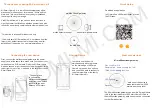
Section 15 APPENDICES
230
ABOUT AUDIO LEVELS
“ Nominal” Levels
The following will help to understand what we mean by
nominal
: A mixing console has
it’s analog VU meter calibrated so that a test tone set to the 0 dB red- green junction
o4 dBu to the Zephyr. The mixer is adjusted so that the VU meter looks
“normal” on a music or voice program. A n4 dBu is being sent to the Zephyr.
Level, Gain, dBu and dBm
We use dBu, rather than dBm, when describing both input and output levels. dBu is
decibels referred to a voltage of 0.7746 volts; unlike dBm, it does not imply any value of
circuit impedance or power. The Zephyr, as with most modern broadcasting and pro
audio equipment, has an output impedance much lower than the input impedance. It
operates on a voltage transfer basis and therefore, the dBm, as a power unit, is not
appropriate – as the proper unit for voltage based systems is dBu.
dBm is decibels referred to a power level of one milliwatt across 600•. The 0 dBu value
of 0.7746 volts is the voltage across a 600• resistor when exactly one milliwatt is being
dissipated in the resistor, which means that under the condition that the measurement
is in a 600• circuit, dBu and dBm are numerically equivalent.
Which brings us to our concern here: How does the Zephyr behave when interfaced
with various types of equipment?
Unity gain is obtained when:
•
The Send level is set to +4 dBu, as indicated on the LCD.
•
The rear panel - 10/+4 output switch is set to +4.
•
The load impedance is high.
At the Zephyr send input, modern source equipment with metering designed for
a high impedance load will behave as expected – the Zephyr’s input meter will
correspond to the source’s output meter. Older equipment which has a 600• source
impedance and output metering calibrated for a 600• load will appear to send 6 dB
more level. This can be corrected by adding an external 600• terminating resistor, or by
simply adjusting the send level, either at the Zephyr or at the source equipment.
At the Zephyr receive output, there is a 200• source impedance. When connected to a
high impedance input, there will be the expected level. However, if the output is
HOT TIP!
In this condition, the system should be used with n4
dBu program signals for proper headroom and signal-to-noise
performance.
Summary of Contents for Zephyr
Page 13: ...Table of Contents 13 SECTION 1 QUICK RESULTS ...
Page 26: ...Section 2 INTRODUCTION 26 This page intentially left blank ...
Page 27: ...Section 2 INTRODUCTION 27 SECTION 2 INTRODUCTION ...
Page 38: ...Section 2 INTRODUCTION 38 This page intentionally left blank ...
Page 39: ...39 SECTION 3 ZEPHYR AT A GLANCE ...
Page 52: ...Section 4 INSTALLATION BASIC OPERATION 52 This page intentionally left blank ...
Page 53: ...Section 4 INSTALLATION BASIC OP 53 SECTION 4 INSTALLATION BASIC OPERATION ...
Page 84: ...Section 4 INSTALLATION BASIC OPERATION 84 ...
Page 85: ...Section 5 ISDN 85 SECTION 5 ISDN ...
Page 105: ...Section 6 NON ISDN NETWORKS 105 SECTION 7 AUDIO CODING ...
Page 118: ...Section 7 AUDIO CODING PRINCIPLES 118 This page intentionally left blank ...
Page 119: ...Section 8 DETAILED MENU REFERENCE 119 SECTION 8 DETAILED MENU REFERENCE ...
Page 157: ...Section 9 REMOTE CONTROL 157 SECTION 9 REMOTE CONTROL ...
Page 176: ...Section 9 REMOTE CONTROL 176 This page intentionally left blank ...
Page 177: ...Section 10 ADVANCED PROBLEM SOLVING 177 SECTION 10 ADVANCED PROBLEM SOLVING ...
Page 196: ...Section 10 ADVANCED PROBLEM SOLVING 196 This page intentionally left blank ...
Page 197: ...Section 11 TECHNICAL INFORMATION 197 SECTION 11 DETAILED TECHNICAL INFORMATION ...
Page 219: ...Section 12 SCHEMATICS 219 SECTION 12 SCHEMATICS ...
Page 221: ...Section 13 MANUFACTURER S DATA SHEETS 221 SECTION 13 MANUFACTURER S DATA SHEETS ...
Page 223: ...Section 14 SPECIFICATIONS WARRANTY 223 SECTION 14 SPECIFICATIONS AND WARRANTY ...
Page 228: ...228 This page intentionally left blank ...
Page 229: ...Section 15 APPENDICES 229 SECTION 15 APPENDICES ...
















































